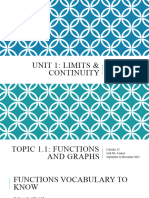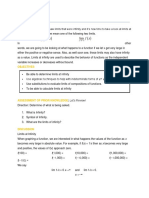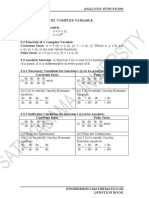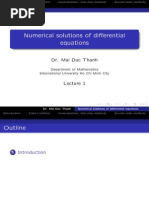Numerical Optimization With Mathematica
Uploaded by
Dennis La CoteraNumerical Optimization With Mathematica
Uploaded by
Dennis La CoteraPrinted from the Complete Wolfram Language Documentation 1
TUTORIAL Related Tutorials Functions URL
Numerical Optimization
FindMinimum f , x,x0 search for a local minimum of f , starting at x x0
FindMinimum f ,x search for a local minimum of f
FindMinimum f , x,x0 , y,y0 ,
search for a local minimum in several variables
FindMinimum f ,cons , x,x0 , y,y0 ,
search for a local minimum subject to the constraints
cons starting at x x0 , y y0 ,
FindMinimum f ,cons , x,y, search for a local minimum subject to the constraints
cons
FindMaximum f ,x , etc. search for a local maximum
Searching for local minima and maxima.
This finds the value of x which minimizes x , starting at x 2.
In[1]:= FindMinimum Gamma x , x, 2
encuentra mín gamma de Euler
Out[1]= 0.885603, x 1.46163
The last element of the list gives the value at which the minimum is achieved.
In[2]:= Gamma x . Last
gamma de Eu último
Out[2]= 0.885603
Like FindRoot , FindMinimum and FindMaximum work by starting from a point, then progressively searching for a minimum or maximum. But
since they return a result as soon as they find anything, they may give only a local minimum or maximum of your function, not a global one.
This curve has two local minima.
In[3]:= Plot x ^ 4 3 x^2 x, x, 3, 2
representación gráfica
Out[3]=
1988–2018 Wolfram Research, Inc. All rights reserved. http://reference.wolfram.com/language
Printed from the Complete Wolfram Language Documentation 2
Starting at x 1, you get the local minimum on the right.
In[4]:= FindMinimum x ^ 4 3 x^2 x, x, 1
encuentra mínimo
Out[4]= 1.07023, x 1.1309
This gives the local minimum on the left, which in this case is also the global minimum.
In[5]:= FindMinimum x ^ 4 3 x^2 x, x, 1
encuentra mínimo
Out[5]= 3.51391, x 1.30084
You can specify variables without initial values.
In[6]:= FindMinimum x ^ 4 3 x^2 x, x
encuentra mínimo
Out[6]= 1.07023, x 1.1309
You can specify a constraint.
In[7]:= FindMinimum x^4 3 x^2 x, x 0 ,x
encuentra mínimo
Out[7]= 3.51391, x 1.30084
NMinimize f ,x try to find the global minimum of f
NMinimize f , x,y, try to find the global minimum over several variables
NMaximize f ,x try to find the global maximum of f
NMaximize f , x,y, try to find the global maximum over several variables
Finding global minima and maxima.
This immediately finds the global minimum.
In[8]:= NMinimize x ^ 4 3 x^2 x, x
minimiza aproximadamente
Out[8]= 3.51391, x 1.30084
NMinimize and NMaximize are numerical analogs of Minimize and Maximize . But unlike Minimize and Maximize they usually cannot guarantee
to find absolute global minima and maxima. Nevertheless, they typically work well when the function f is fairly smooth, and has a limited
number of local minima and maxima.
NMinimize f ,cons , x,y, try to find the global minimum of f subject to
constraints cons
NMaximize f ,cons , x,y, try to find the global maximum of f subject to
constraints cons
Finding global minima and maxima subject to constraints.
1988–2018 Wolfram Research, Inc. All rights reserved. http://reference.wolfram.com/language
Printed from the Complete Wolfram Language Documentation 3
With the constraint x 0, NMinimize will give the local minimum on the right.
In[9]:= NMinimize x^4 3 x^2 x, x 0 ,x
minimiza aproximadamente
Out[9]= 1.07023, x 1.1309
This finds the minimum of x 2 y within the unit circle.
In[10]:= NMinimize x 2 y, x ^ 2 y^2 1 , x, y
minimiza aproximadamente
Out[10]= 2.23607, x 0.447214, y 0.894427
In this case Minimize can give an exact result.
In[11]:= Minimize x 2 y, x ^ 2 y^2 1 , x, y
minimiza
4 2
Out[11]= 5 , x 5 ,y
5 5
But in this case it cannot.
In[12]:= Minimize Cos x 2 y , x^2 y^2 1 , x, y
minimiza coseno
Out[12]= MinimizeCos x 2 y , x2 y2 1, x, y
This gives a numerical approximation, effectively using NMinimize .
In[13]:= N
valor numérico
Out[13]= 0.617273, x 0.447214, y 0.894427
If both the objective function f and the constraints cons are linear in all variables, then minimization and maximization correspond to a linear
programming problem. Sometimes it is convenient to state such problems not in terms of explicit equations, but instead in terms of matrices
and vectors.
LinearProgramming c,m,b find the vector x which minimizes c.x subject to the
constraints m.x b and x 0
LinearProgramming c,m,b,l use the constraints m.x b and x l
Linear programming in matrix form.
Here is a linear programming problem in equation form.
In[14]:= Minimize 2x 3 y, x 5y 10, x y 2, x 1 , x, y
minimiza
32 10 4
Out[14]= , x ,y
3 3 3
Here is the corresponding problem in matrix form.
In[15]:= LinearProgramming 2, 3 , 1, 5 , 1, 1 , 1, 0 , 10, 2, 1
programación lineal
10 4
Out[15]= ,
3 3
You can specify a mixture of equality and inequality constraints by making the list b be a sequence of pairs bi , si . If si is 1, then the ith constraint
is mi .x bi . If si is 0 then it is mi .x bi , and if si is 1 then it is mi .x bi .
1988–2018 Wolfram Research, Inc. All rights reserved. http://reference.wolfram.com/language
Printed from the Complete Wolfram Language Documentation 4
This makes the first inequality use .
In[16]:= LinearProgramming 2, 3 , 1, 5 , 1, 1 , 1, 0 , 10, 1 , 2, 1 , 1, 1
programación lineal
Out[16]= 2, 0
In LinearProgramming c, m, b, l , you can make l be a list of pairs l1 , u1 , l2 , u2 , representing lower and upper bounds on the xi .
In doing large linear programming problems, it is often convenient to give the matrix m as a SparseArray object.
Related Tutorials
Numerical Operations on Functions
1988–2018 Wolfram Research, Inc. All rights reserved. http://reference.wolfram.com/language
You might also like
- Instant Download (eBook PDF) Applied Calculus for the Managerial, Life, and Social Sciences 10th Edition PDF All Chapters89% (9)Instant Download (eBook PDF) Applied Calculus for the Managerial, Life, and Social Sciences 10th Edition PDF All Chapters46 pages
- MTH101 Practice Qs Solutions Lectures 23 To 4586% (7)MTH101 Practice Qs Solutions Lectures 23 To 4527 pages
- Optimization: ES 204 Numerical Methods in EngineeringNo ratings yetOptimization: ES 204 Numerical Methods in Engineering15 pages
- Lecture 3: Lagrangian Duality and Algorithms For The Lagrangian Dual ProblemNo ratings yetLecture 3: Lagrangian Duality and Algorithms For The Lagrangian Dual Problem47 pages
- Optimization Using Calculus: Stationary Points: Functions of Single and Two VariablesNo ratings yetOptimization Using Calculus: Stationary Points: Functions of Single and Two Variables28 pages
- Computational Lab in Physics: Finding Roots of Nonlinear FunctionsNo ratings yetComputational Lab in Physics: Finding Roots of Nonlinear Functions12 pages
- Princeton University Notation and Terminology in optimizationNo ratings yetPrinceton University Notation and Terminology in optimization13 pages
- Section 2-4: Limits Properties: Lim Lim Lim LimNo ratings yetSection 2-4: Limits Properties: Lim Lim Lim Lim7 pages
- MTH4100 Calculus I: Lecture Notes For Week 8 Thomas' Calculus, Sections 4.1 To 4.4No ratings yetMTH4100 Calculus I: Lecture Notes For Week 8 Thomas' Calculus, Sections 4.1 To 4.411 pages
- What Do Limits Have To Do With Calculus?: An Unlimited Review of LimitsNo ratings yetWhat Do Limits Have To Do With Calculus?: An Unlimited Review of Limits18 pages
- Unconstrained and Constrained OptimizationNo ratings yetUnconstrained and Constrained Optimization31 pages
- CALENG1 Lesson 01b Introduction To Calculus and Limits Edited by LFRNo ratings yetCALENG1 Lesson 01b Introduction To Calculus and Limits Edited by LFR63 pages
- Chapter 4 Application of Derivative IIINo ratings yetChapter 4 Application of Derivative III42 pages
- Mathematica 12. Insetting Objects in GraphicsNo ratings yetMathematica 12. Insetting Objects in Graphics3 pages
- Lectures On Fourier Analysis by S.ThangaveluNo ratings yetLectures On Fourier Analysis by S.Thangavelu53 pages
- Numerical Solutions of Differential Equations: Dr. Mai Duc ThanhNo ratings yetNumerical Solutions of Differential Equations: Dr. Mai Duc Thanh47 pages
- 18 03sc Fall 2011 Differential EquationsNo ratings yet18 03sc Fall 2011 Differential Equations602 pages
- MTH 103 Calculus One Course Outline - Revised April 15-2018No ratings yetMTH 103 Calculus One Course Outline - Revised April 15-201811 pages
- An Introduction To Partial Differential Equations: Daniel ArrigoNo ratings yetAn Introduction To Partial Differential Equations: Daniel Arrigo208 pages
- Today:: + Cos + Sin ,:, Arg Arg + Arg +No ratings yetToday:: + Cos + Sin ,:, Arg Arg + Arg +20 pages
- Taylor Series & Maclaurin's Series Notes by Trockers100% (1)Taylor Series & Maclaurin's Series Notes by Trockers24 pages
- Week 017 Visual Calculus - Fundamental Theorem of CalculusNo ratings yetWeek 017 Visual Calculus - Fundamental Theorem of Calculus2 pages
- Math Syllabus (UG) CBCS (UGC) RUSA - 12 PDFNo ratings yetMath Syllabus (UG) CBCS (UGC) RUSA - 12 PDF133 pages
- L4 Examples - Exact Differential Equations PDFNo ratings yetL4 Examples - Exact Differential Equations PDF16 pages
- Analytic Extensions of Differentiable Functions Defined in Closed Sets - WhitneyNo ratings yetAnalytic Extensions of Differentiable Functions Defined in Closed Sets - Whitney27 pages
- Instant Download (eBook PDF) Applied Calculus for the Managerial, Life, and Social Sciences 10th Edition PDF All ChaptersInstant Download (eBook PDF) Applied Calculus for the Managerial, Life, and Social Sciences 10th Edition PDF All Chapters
- Optimization: ES 204 Numerical Methods in EngineeringOptimization: ES 204 Numerical Methods in Engineering
- Lecture 3: Lagrangian Duality and Algorithms For The Lagrangian Dual ProblemLecture 3: Lagrangian Duality and Algorithms For The Lagrangian Dual Problem
- Optimization Using Calculus: Stationary Points: Functions of Single and Two VariablesOptimization Using Calculus: Stationary Points: Functions of Single and Two Variables
- Computational Lab in Physics: Finding Roots of Nonlinear FunctionsComputational Lab in Physics: Finding Roots of Nonlinear Functions
- Princeton University Notation and Terminology in optimizationPrinceton University Notation and Terminology in optimization
- MTH4100 Calculus I: Lecture Notes For Week 8 Thomas' Calculus, Sections 4.1 To 4.4MTH4100 Calculus I: Lecture Notes For Week 8 Thomas' Calculus, Sections 4.1 To 4.4
- What Do Limits Have To Do With Calculus?: An Unlimited Review of LimitsWhat Do Limits Have To Do With Calculus?: An Unlimited Review of Limits
- CALENG1 Lesson 01b Introduction To Calculus and Limits Edited by LFRCALENG1 Lesson 01b Introduction To Calculus and Limits Edited by LFR
- Numerical Solutions of Differential Equations: Dr. Mai Duc ThanhNumerical Solutions of Differential Equations: Dr. Mai Duc Thanh
- MTH 103 Calculus One Course Outline - Revised April 15-2018MTH 103 Calculus One Course Outline - Revised April 15-2018
- An Introduction To Partial Differential Equations: Daniel ArrigoAn Introduction To Partial Differential Equations: Daniel Arrigo
- Taylor Series & Maclaurin's Series Notes by TrockersTaylor Series & Maclaurin's Series Notes by Trockers
- Week 017 Visual Calculus - Fundamental Theorem of CalculusWeek 017 Visual Calculus - Fundamental Theorem of Calculus
- Analytic Extensions of Differentiable Functions Defined in Closed Sets - WhitneyAnalytic Extensions of Differentiable Functions Defined in Closed Sets - Whitney






























































































